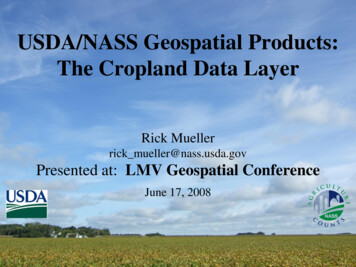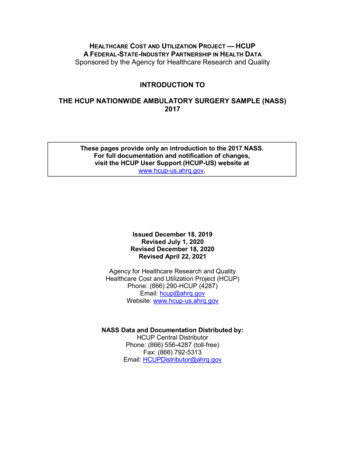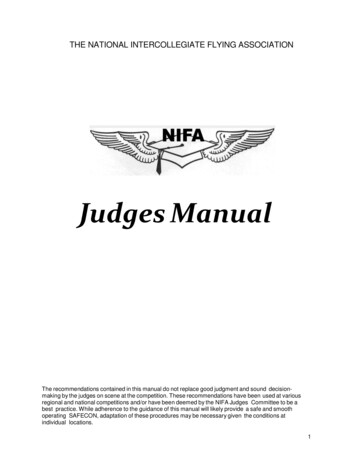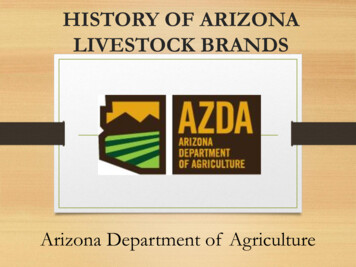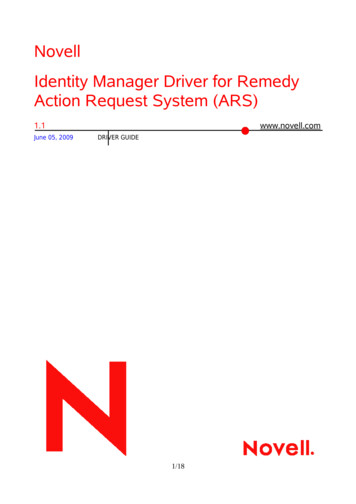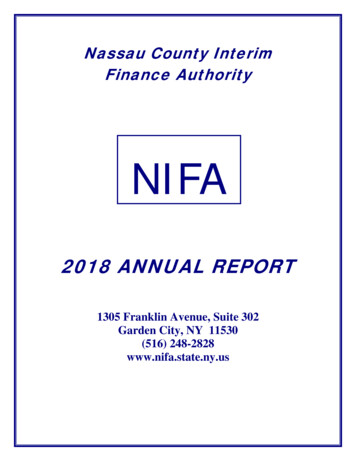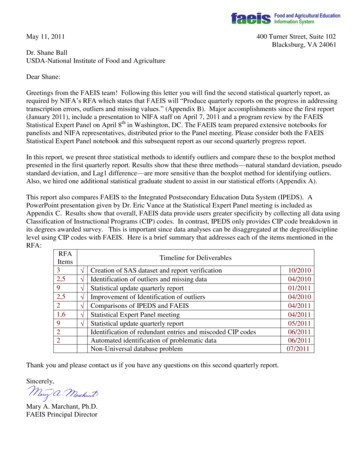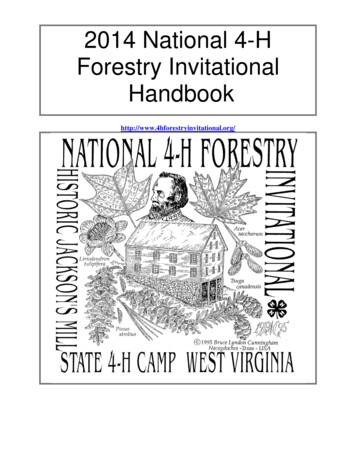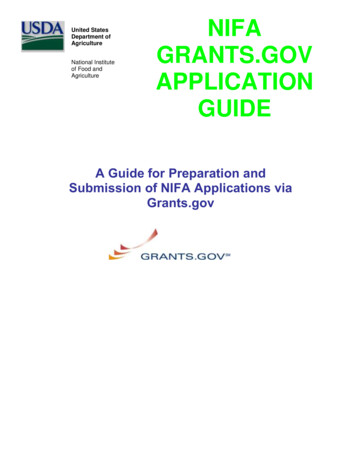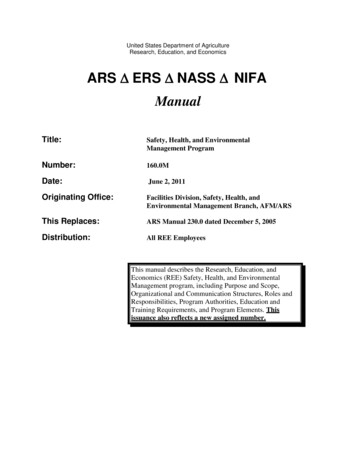
Transcription
United States Department of AgricultureResearch, Education, and EconomicsARS ERS NASS NIFAManualTitle:Safety, Health, and EnvironmentalManagement ProgramNumber:160.0MDate:June 2, 2011Originating Office:Facilities Division, Safety, Health, andEnvironmental Management Branch, AFM/ARSThis Replaces:ARS Manual 230.0 dated December 5, 2005Distribution:All REE EmployeesThis manual describes the Research, Education, andEconomics (REE) Safety, Health, and EnvironmentalManagement program, including Purpose and Scope,Organizational and Communication Structures, Roles andResponsibilities, Program Authorities, Education andTraining Requirements, and Program Elements. Thisissuance also reflects a new assigned number.
Table of ContentsGeneral . 51. Purpose . 52. Applicability . 53. REE Policy Statement . 5Safety Management . 6Occupational Health Management . 7Industrial Hygiene . 7Environmental Management . 7Radiation Safety . 7Biological Safety . 74. Maintenance of this Manual . 85. Definitions . 86. Authorities . 97. Abbreviations . 108. SHEM Standards . 12Basic Responsibilities for Standards . 12Procedures for Standards Adoption . 12New, Amended, or Supplementary Standards. 13Conflicting Standards . 13Emergency Temporary Standards . 13Access to Standards . 14Conformance to Standards . 149. Organizational Structure, Communications, and Records Retention. 14REE Organizational Structure. 15Internal Communications . 15External Communications . 16Records Retention . 1610. Annual Goals and Objectives . 1611. Responsibilities . 1712. Basic Employee Rights . 3113. Reprisals . 3114. Education/Training . 3215. Awards and Promotional Activities . 3216. Calendar of Reporting Events . 33Safety Management . 3317.18.19.20.Postings . 33Safety Committees . 33Facilities Design and Construction . 34Accident/Illness Reporting, Recording, Investigation, and Analysis . 34Accident Reporting . 35Accident/Illness Investigation and Recording . 352
OSHA Forms 300, 300A, and 301 . 3621. Public Visitor Protection . 3722. Inspection and Abatement. 37Hazard Abatement Plans . 38Employee Reporting of Unsafe or Unhealthful Working Conditions . 3923. Onsite Assistance Reviews . 3924.25.26.27.Controlled Substances . 39Storage, Preparation, and Consumption of Food and Beverages in Facilities . 40Hazard Communication . 40Standards for Federal Supply/Service Contracts and Extramural Agreements . 42Safety and Health Standards for Federal Supply Contracts . 42Safety and Health Standards for Federal Service Contracts . 43Safety and Health Standards for REE Grants and Agreements . 44Sample Statement of Work . 44Occupational Health Management . 4428. Employee Assistance Program . 4429. Occupational Medical Surveillance Program . 4530. REE Workers’ Compensation Program . 45Industrial Hygiene . 4631.32.33.34.35.36.37.Industrial Hygiene . 46Asbestos Management. 47Chemical Hygiene . 48Personal Protective Equipment . 49Hearing Conservation. 49Respiratory Protection . 50ARS Ventilation and Laboratory Chemical Fume Hood Standards . 50Environmental Management . 5138. Environmental Management System. 51EMS Policy Statement . 52EMS Declaration of Conformance . 53Environmental Planning . 5439. National Environmental Policy Act . 54NEPA Process for Construction Projects . 5540. Funding . 56Hazardous Waste Cleanup Funds . 57Agency Funds. 57Funding Priorities. 57Environmental Protection . 5741. Wetlands . 5842. Coastal Zone Act. 5843. Endangered Species Act . 583
44.45.46.47.48.49.50.51.52.Fish and Wildlife Populations and Habitats . 59Invasive Species . 59Outdoor Recreation . 60National Historical Preservation Act . 60Pollution Prevention . 60Sustainability . 61Oil Pollution Act . 62Underground Storage Tanks . 62Ozone-Depleting Substances . 63Environmental Compliance . 6453. Clean Air Act . 6554. Clean Water Act . 6555. Safe Drinking Water Act . 6656. Resource Conservation and Recovery Act . 6657. Comprehensive Environmental Response, Compensation, and Liability Act. 6858. Emergency Planning and Community Right-to-Know Act . 6959. Toxic Substances Control Act . 6960. Federal Insecticide, Fungicide, and Rodenticide Act . 7061. Reporting Hazardous Substance Activity When Selling or Transferring RealProperty. 7062. Compliance Auditing . 714
General1. PurposeThis manual has been prepared to serve as a reference for management officials, supervisors, andemployees. It incorporates elements of various laws, regulations, and executive orders (EOs)that require the head of each Federal agency to establish a Safety, Health, and EnvironmentalManagement (SHEM) program. When REE is operating in jurisdictions with more stringentsafety, health, and environmental requirements, they will be applied.The SHEM program is REE’s plan to effect optimal achievement of error-free and, therefore,accident-free task performance that involves employee, machine, and environmentalrelationships. Within REE, the SHEM program encompasses the related functional areas ofsafety management, occupational health management, industrial hygiene, and environmentalmanagement. ARS has developed separate Radiation Safety and Biological Safety programs;however, these programs collaborate closely with the SHEM program.2. ApplicabilityThe contents of this manual are applicable to all REE agencies; i.e., ARS, ERS, NASS, andNIFA, under the direction of the administrators whether accomplished by agency personnel,cooperators, or contractors. Exceptions to the provisions of this manual require the ARSAdministrator’s approval. Waivers will be documented and copies furnished to the next highermanagement level. In all instances, however, program coverage consistent with the intent of thepertinent provisions must be provided.3. REE Policy StatementIt is REE policy to eliminate or minimize losses incurred by the agencies, individual employees,and the general public as a result of actions or incidents involving or producing injury, illness,and property/environmental damage in the workplace by: Implementing the agencies’ program for safety, health, and environmental management. Complying with the spirit and letter of Federal, State, and local safety, health, andenvironmental laws, regulations, EOs, and related standards, policies, etc. Establishing procedures to prevent accident-related losses for procurement, repair,storage, waste management/disposal, and salvage operations.5
Providing supervisory/employee education/training opportunities for communicatingprogram function components. Properly assigning, directing, and training REE employees in SHEM related activities. Developing supervisory safety, health, and environmental related knowledge and skills. Compensating for human factors/errors that have an undesirable effect upon REE. Developing occupant emergency plans for emergency situations. Developing and implementing program promotional activities. Conducting hazard assessments to identify potentially hazardous conditions or adverseenvironmental consequences. Developing standard operating procedures that minimize or eliminate potentiallyhazardous conditions or adverse environmental effects. Protecting employees from hazardous conditions through isolation, guarding, shieldingprinciples or substitution, or personal protective equipment. Developing policies and procedures that minimize or eliminate potentially hazardousconditions or adverse personal effects through chemical labeling, hygiene, proper storageand disposal, and by inventorying chemicals and hazardous substances/materials. Developing procedures for researching, measuring, and reporting of safety, health, andenvironmental related data. Developing programs for reviewing, inspecting/auditing, and complying with the SHEMprogram. Incorporating the SHEM program components into daily routines.REE agencies will take appropriate action to correct deficiencies and provide a consistent levelof program support to implement and maintain an acceptable SHEM program as required byFederal, State, and local laws and regulations.Safety ManagementThe objective of the safety management function is to furnish employees a work place that is freeof recognized hazards that are causing or likely to cause death or serious physical harm.6
Occupational Health ManagementThe objective of the occupational health management function is to promote healthful workingconditions by establishing programs to recognize, evaluate, and correct occupational healthhazards.Industrial HygieneThe objective of the industrial hygiene function is to protect the health and well-being of peopleby anticipating, recognizing, evaluating, and controlling adverse environmental conditions orstresses in the workplace.Environmental ManagementThe objective of the environmental management function is to develop, implement, manage andevaluate programs to: protect the human and natural environment;provide stewardship of natural and other resources under REE’s control;prevent, control, and abate pollution at agency facilities;protect agency personnel from administrative, civil, and criminal penalties and liability;andcomply with substantive and procedural environmental requirements associated withproject planning, property disposal, facility construction, and operation and programexecution.Radiation SafetyThe Radiation Safety program is administered Department-wide by USDA’s Radiation SafetyDivision (RSD) and the Office of National Programs (ONP). The objective of this program is tosafeguard personnel, property, and the community at large from the potential hazards of radiationfrom all possible sources and, thereby, minimize legal risks associated with the presence or useof ionizing radiation. Specific program policy guidelines can be found in the USDA’s RadiationSafety Handbook and on the RSD Web site.Biological SafetyThe ARS Biosafety Officer administers the Biological Safety program within the ONP. Theobjective of this program is to prevent or minimize employee exposure or the accidental releaseto the environment of hazardous biological agents through the promotion of safe laboratorypractices, procedures, and proper use of containment and facilities.Manual 242.1, ARS Facilities Design Standards, Chapter 9, Biohazard Containment Design,addresses requirements and considerations for design of containment facilities. The chapterdiscusses hazard classification and choice of containment; architectural, mechanical, andelectrical design features; testing and certification requirements for critical components of the7
containment system; and bid document preparation. Specific program policy and guidelines canbe found in the USDA Departmental Regulation (DR) 4400-007, Biological Safety Program;USDA Departmental Manual (DM) 9610-001, USDA Security Policies and Procedures forBiosafety Level 3 Facilities; DM 9610-002, USDA Security Policies and Procedures forLaboratories and Technical Facilities; and DR 9630-001, Policy and Procedures on BiohazardousWaste Decontamination, Management and Quality Controls at Laboratories and TechnicalFacilities.4. Maintenance of this ManualThe Safety, Health, and Environmental Management Branch (SHEMB), Facilities Division (FD),is responsible for the issuance of any amendments to this manual. The manual will be updated asrequired to maintain compliance with new or revised Federal, State, and local laws, regulations,EO, and related standards, policies, etc.Where references are made to Web sites, a hard copy will be made available to anyone nothaving access to the information. Contact your servicing location, Area, or Agency SHEMrepresentative.5. DefinitionsThe intent of this section is to promote a common understanding of technical terms anddefinitions. The following is a list of terms and definitions pertinent to the technology andpractice of SHEM within the REE agencies. Accident - An unplanned event that causes injury, illness or property damage. Hazard - Chemical, biological, radiological, physical, or behavioral obstruction of safetask performance which might allow an unfavorable extent of chance danger, peril, orrisk, resulting in losses. Industrial Hygiene - The scientific discipline devoted to protecting the health and wellbeing of people at work by anticipating, recognizing, evaluating, and controlling adverseenvironmental factors or stresses arising in the workplace. SHEM Program - REE’s plan to effect optimal achievement of error-free and, therefore,accident-free task performance which involves employee, machine, and environmentalrelationships. Within REE, the SHEM program encompasses the related functional areasof safety management, occupational health management, industrial hygiene, andenvironmental management.8
6. AuthoritiesAuthority for programs to prevent accidents/incidents involving people, personal property, andthe environment, with respect to the operations of the Federal Government, is provided invarious laws, regulations, EO, and related standards, policies, etc. In some jurisdictions, morestringent State or local standards may govern mission activities. The following list contains onlythose minimum Federal requirements that apply REE-wide. Other authorities may be applicable.The major authorities behind the SHEM program are: 7 CFR 1b, National Environmental Policy Act;7 CFR 2, Delegations of Authority by the Assistant Secretary for Administration;7 CFR 331, Possession, Use, and Transfer of Select Agents/Toxins;7 CFR 520, Procedures for Implementing National Environmental Policy Act;9 CFR 121, Possession, Use, and Transfer of Select Agents/Toxins;10 CFR 19, Notices, Instructions, and Reports to Workers: Inspection and Investigation;10 CFR 20, Standards for Protection Against Radiation;10 CFR 30, Rules of General Applicability to Domestic Licensing of Byproduct Material;20 CFR 10, Federal Employees’ Compensation Act;29 CFR 1605, Equal Employment Opportunity Commission;29 CFR 1904, Recording and Reporting Occupational Injuries and Illnesses29 CFR 1910, Occupational Safety and Health Standards;29 CFR 1925, Safety and Health Standards for Federal Service Contracts;29 CFR 1926, Safety and Health Regulations for Construction;29 CFR 1928, Occupational Safety and Health Standards for Agriculture;29 CFR 1960, Basic Program Elements for Federal Employee Occupational Safety andHealth Programs;40 CFR 1 to end, Protection of the Environment;42 CFR 73, Select Agents and Toxins;49 CFR 171 to 178, Hazardous Materials Regulations;49 CFR 173, Shippers – General Requirements for Shipments and Packages;EO 12088, Federal Compliance with Pollution Control Standards;EO 12196, Occupational Safety and Health Programs for Federal Employees;EO 12372, Intergovernmental Review of Federal Programs;EO 12580, Superfund Implementation;EO 13112, Invasive Species;EO 13150, Federal Workforce Transportation;EO 13423, Strengthening Federal Environmental, Energy, and TransportationManagement;EO 13514, Federal Leadership in Environmental, Energy, and Economic Performance;DM 5600-1, Environmental Pollution Prevention, Control, and Abatement;DM 9610-001, USDA Security Policies and Procedures for Biosafety Level-3 FacilitiesDM 9610-002, USDA Security Policies and Procedures for Laboratories and TechnicalFacilities9
DR 4410-004, Safety Management Program;DR 4430-003, Workers’ Compensation Program;DR 9630-001, Policy and Procedures on Biohazardous Waste Decontamination,Management, and Quality Controls at Laboratories and Technical Facilities;P&P 115, Delegations of Authority;P&P 116, Freedom of Information Act and Privacy Act Guidelines;P&P 124.1-ARS, Radiation Safety Program ARS;P&P 134.2-ARS, Energy, Water, and Sustainability Policy;P&P 235.0-ARS, ARS Occupational Medical Surveillance Program;P&P 242.1M-ARS, ARS Facilities Design Standards;P&P 242.4M-ARS, Major Facilities Construction ManualP&P 245.1, Real Property Manual;P&P 251.8, Records Management;P&P 461.5, Misconduct, Discipline, and Adverse Actions;P&P 600.12-ARS, Guidelines and Precautions to Be Taken By Personnel in Storing,Using, Handling, and Disposing of Agricultural Chemical Pesticides; andHHS Publication No. (CDC) 21-1112, Biosafety in Microbiological and BiomedicalLaboratories.7. Abbreviations ACM - Asbestos-Containing MaterialAD - Area DirectorA-E - Architect-EngineerAFM - Administrative and Financial ManagementAPD - Acquisition and Property DivisionARS - Agricultural Research ServiceASHM - Area Safety and Health ManagerCAA - Clean Air ActCARE - Consolidated Assistance Review and EvaluationCDSO - Collateral Duty Safety OfficerCEPS - Cluster Environmental Protection SpecialistCERCLA - Comprehensive Environmental Response, Compensation, and Liability ActCFC - ChlorofluorocarbonCFR - Code of Federal RegulationsCORE - Calendar of Reporting EventsCWA - Clean Water ActDAAFM - Deputy Administrator, Administrative and Financial ManagementDAD - Deputy Area Director – Business ManagementDASHO - Designated Agency Safety and Health OfficialDM - Departmental ManualDR - Departmental RegulationEA - Environmental Assessment10
EAP - Employee Assistance ProgramEIS - Environmental Impact StatementEMS - Environmental Management SystemEO - Executive OrderEPA - Environmental Protection AgencyEPCRA - Emergency Planning and Community Right-to-Know ActERS - Economic Research ServiceESA - Environmental Site AssessmentFAR - Federal Acquisition RegulationFD - Facilities DivisionFOIA - Freedom of Information ActFONSI - Finding of No Significant ImpactFWS - Fish and Wildlife ServiceGSA - General Services AdministrationHWC - Hazardous Waste CleanupIH - Industrial HygieneMOU - Memorandum of UnderstandingMSDS - Material Safety Data SheetsNASS - National Agricultural Statistics ServiceNEPA - National Environmental Policy ActNIFA - National Institute of Food and AgricultureNRC - Nuclear Regulatory CommissionOAR - Onsite Assistance ReviewODS - Ozone-Depleting SubstanceOEP - Office of Extramural ProgramsOMSP - Occupational Medical Surveillance ProgramOSHA - Occupational Safety and Health AdministrationONP - Office of National ProgramsOSH Act - Occupational Safety and Health Act of 1970OWCP - Office of Workers’ Compensation ProgramP&P - Policies and ProceduresPL - Public LawPPE - Personal Protective EquipmentRCRA - Resource Conservation and Recovery ActREE - Research, Education, and EconomicsRPMB - Real Property Management BranchRSD - Radiation Safety DivisionSHEM - Safety, Health, and Environmental ManagementSHEMB - Safety, Health, and Environmental Management BranchSOW - Statement of WorkUSC - United States CodeUST - Underground Storage Tank11
8. SHEM StandardsREE is committed to complying with applicable safety, health, and environmental standards. Inorder to achieve and maintain compliance, each organizational level must be aware of thestandards and how they apply to their facilities and operations.It is REE policy to adopt safety, health, and environmental standards associated with applicablelaws, regulations, EOs, and related standards, policies, etc., listed in the Authorities Section ofthis manual. State and local governments may enact standards that are more stringent thanFederal regulations. REE also adopts State, county, and other local standards where applicable.Basic Responsibilities for StandardsThe detailed responsibilities of REE employees are clearly stated in Chapter 11, Responsibilities,of this manual. Basic responsibilities for safety, health, and environmental standards follow: The Chief, SHEMB, FD, acting under authority delegated by the ARS Administrator, willdevelop safety, health, and environmental policies and procedures for general application.The Chief will also serve as the primary interpreter of Federal, State, and local safety,health, and environmental related standards. The Chief will provide guidance andassistance necessary to ensure compliance with applicable safety, health, andenvironmental standards by program officials throughout REE. The Area Directors, Deputy Area Directors, State Directors, Center Directors, ResearchLeaders, and Location Coordinators will maintain, or have accessibility to, a completeand current set of applicable standards. The servicing location, Area, or Agency SHEMrepresentative will be consulted when determining applicable standards for a givenfacility or operation. These officials will provide other managerial support of therequirements and ensure compliance through resource allocation and policies. The servicing location, Area, and Agency SHEM representatives will provide guidanceand assistance necessary to ensure compliance with applicable safety, health, andenvironmental standards. Supervisory and managerial personnel will be knowledgeable of standards that apply totheir work areas and will ensure that employees under their supervision know and followapplicable standards. Employees will be knowledgeable about and will follow the standards that apply to theirareas of work.Procedures for Standards AdoptionEO 12196, Occupational Safety and Health Programs for Federal Employees, requires theSecretary of Labor to provide consultation to agencies as necessary and appropriate to ensureagency standards are consistent with OSHA standards.12
To meet the requirements of EO 12196, REE agencies will adopt OSHA standards published at29 CFR 1904, 1910, 1918, 1926, 1928, and 1960 as REE standards unless a request for anexception is submitted through the Designated Agency Safety and Health Official (DASHO) tothe Department of Labor.The DASHO will submit new safety and health standards that conflict with OSHA standards toOSHA for approval. Requests will include copies of the standard proposed for adoptionarranged to correspond to appropriate subparts of OSHA standards; and information supp
of ionizing radiation. Specific program policy guidelines can be found in the USDA's Radiation Safety Handbook and on the RSD Web site. Biological Safety The ARS Biosafety Officer administers the Biological Safety program within the ONP. The objective of this program is to prevent or minimize employee exposure or the accidental release

